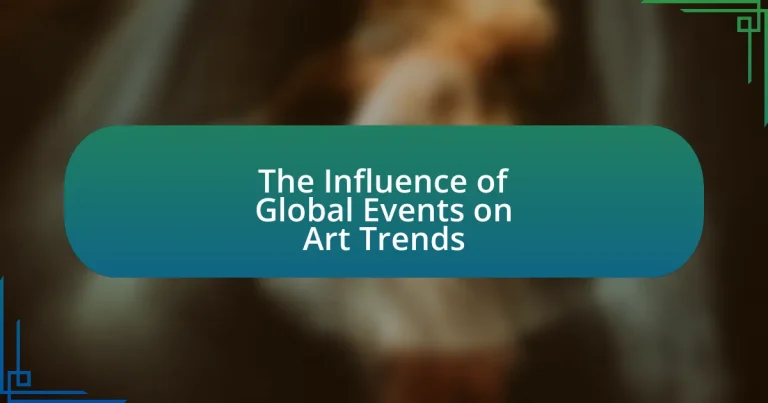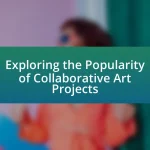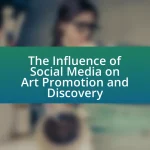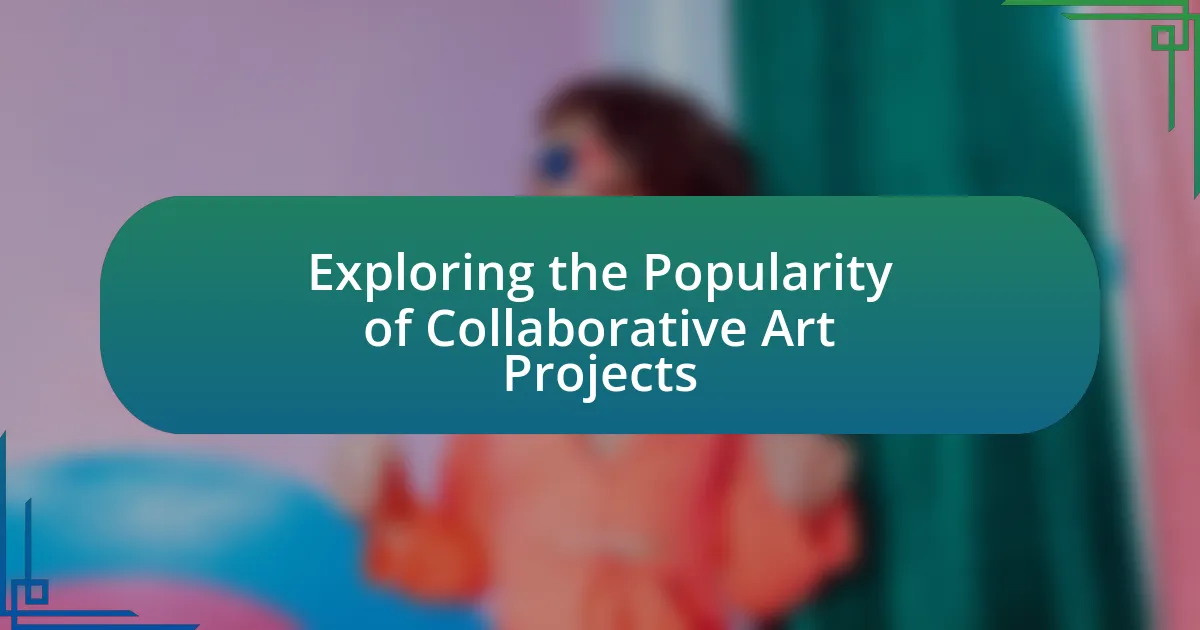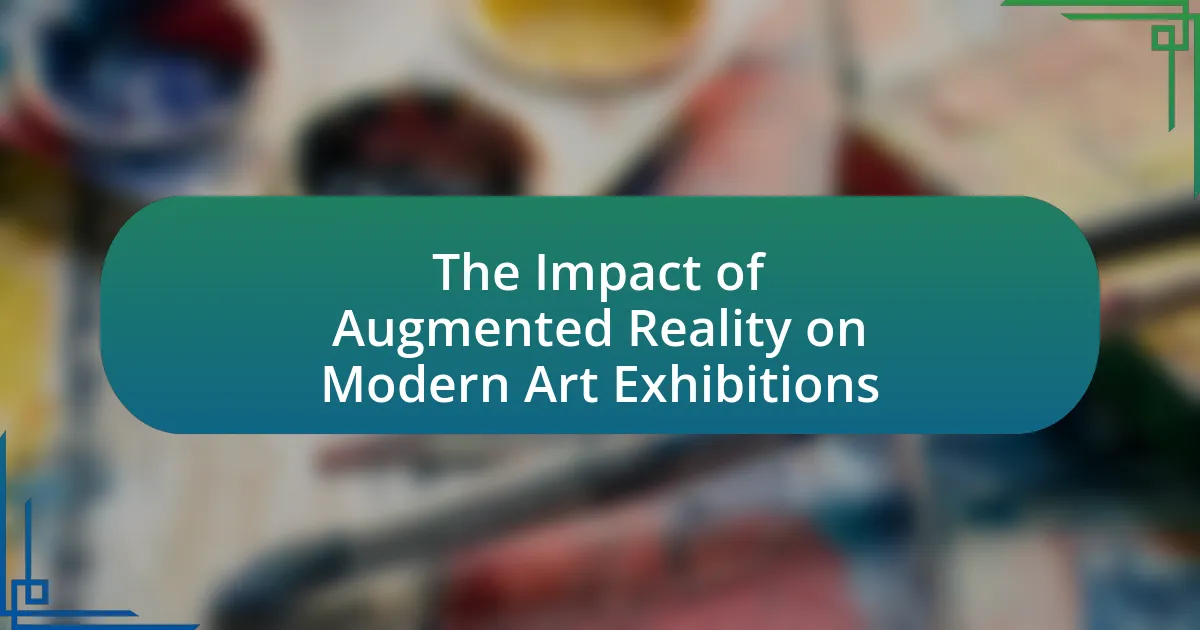The article examines the influence of global events on art trends, highlighting how significant occurrences such as wars, political movements, and crises shape artistic expression. It discusses the emergence of various art movements in response to historical events, including Dadaism and Abstract Expressionism, and explores contemporary themes arising from recent events like the COVID-19 pandemic and the Black Lives Matter movement. The article emphasizes the importance of understanding these connections to appreciate art as a reflection of societal values and to predict future trends in the art world. Additionally, it addresses how artists adapt their practices and engage with audiences through technology and social media in response to global challenges.
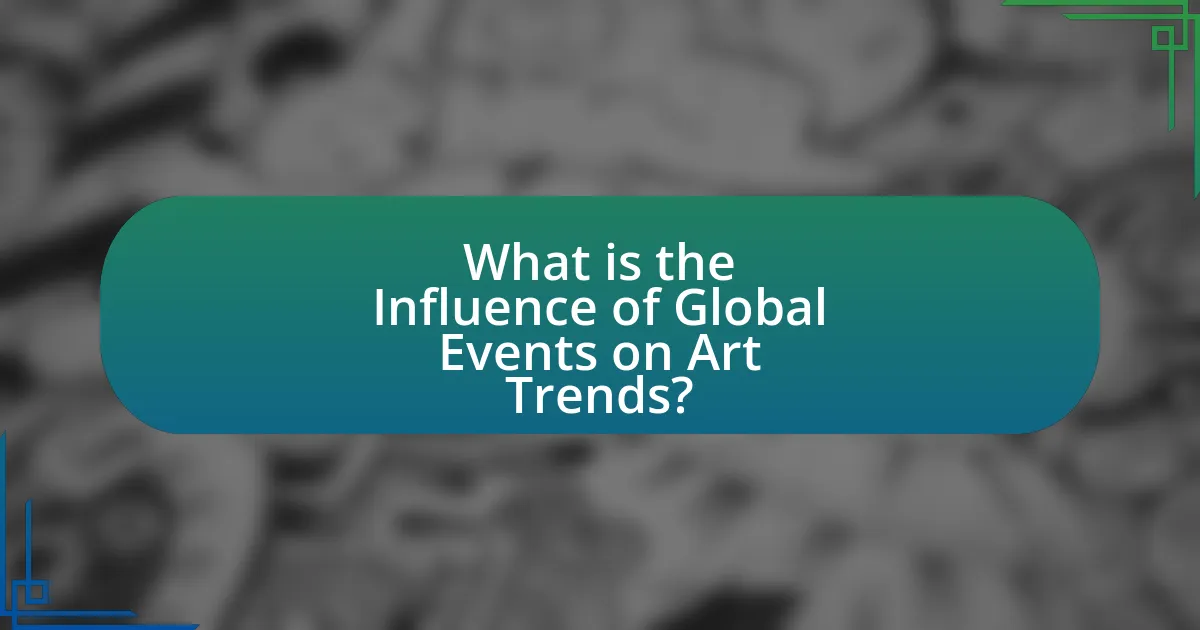
What is the Influence of Global Events on Art Trends?
Global events significantly influence art trends by shaping cultural narratives and artistic expressions. For instance, the COVID-19 pandemic led to a surge in digital art and virtual exhibitions as artists adapted to social distancing measures. Similarly, political movements, such as Black Lives Matter, have inspired artists to create works that address social justice and racial equality, reflecting the urgency of these issues in contemporary society. Historical events, like wars or economic crises, have also historically prompted shifts in artistic styles and themes, as seen in the emergence of Dadaism during World War I, which rejected traditional aesthetics in response to the chaos of the time. These examples illustrate how global events serve as catalysts for change in the art world, influencing both the medium and message of artistic production.
How do global events shape artistic expression?
Global events significantly shape artistic expression by influencing themes, styles, and mediums used by artists. For instance, the impact of World War II led to the emergence of movements like Abstract Expressionism, which reflected the chaos and trauma of the time. Similarly, the civil rights movement in the United States inspired artists to address social justice issues through their work, as seen in the powerful imagery of the Black Arts Movement. Additionally, contemporary global events, such as climate change and political unrest, have prompted artists to engage with these topics, resulting in art that raises awareness and provokes dialogue. This connection between global events and artistic expression demonstrates how societal contexts drive creativity and innovation in the arts.
What types of global events have the most significant impact on art?
Global events that have the most significant impact on art include wars, political revolutions, economic crises, and cultural movements. For instance, World War I and II profoundly influenced artists, leading to movements like Dadaism and Surrealism, which reflected the chaos and disillusionment of the times. The Russian Revolution inspired the Constructivist movement, emphasizing art’s role in social change. Economic downturns, such as the Great Depression, shifted artistic focus towards realism and social commentary, as seen in the works of artists like Dorothea Lange. Cultural movements, such as the Civil Rights Movement in the United States, spurred artistic expressions that addressed social justice and identity, exemplified by artists like Faith Ringgold. These events shape artistic themes, styles, and the overall direction of art history.
How do artists respond to global crises through their work?
Artists respond to global crises through their work by creating pieces that reflect, critique, or raise awareness about the issues at hand. For instance, during the COVID-19 pandemic, many artists produced works that explored themes of isolation, loss, and resilience, using mediums such as painting, photography, and digital art to convey their messages. Historical examples include Picasso’s “Guernica,” which powerfully depicted the horrors of war and its impact on civilians, serving as a political statement against violence. This demonstrates how artists not only document societal challenges but also provoke thought and inspire action, making their work a vital part of the discourse surrounding global crises.
Why is it important to study the relationship between global events and art trends?
Studying the relationship between global events and art trends is important because it reveals how societal changes influence artistic expression. For instance, the impact of World War II on the emergence of Abstract Expressionism illustrates how artists responded to trauma and upheaval, reflecting broader cultural sentiments. Additionally, economic shifts, such as the Great Depression, led to the rise of social realism in art, emphasizing the struggles of everyday life. Understanding these connections allows for a deeper appreciation of art as a mirror of historical context, providing insights into human experiences and societal values during specific periods.
What insights can we gain about society from art influenced by global events?
Art influenced by global events provides insights into societal values, emotions, and reactions to significant occurrences. For instance, during the COVID-19 pandemic, artists created works that reflected themes of isolation, resilience, and community, showcasing how society coped with unprecedented challenges. The Black Lives Matter movement inspired a surge in art addressing racial injustice, highlighting societal awareness and calls for change. These artistic expressions serve as historical documentation, revealing public sentiment and cultural shifts in response to global crises. Such art not only mirrors societal issues but also fosters dialogue and reflection, indicating the collective consciousness of a community during pivotal moments.
How does understanding this influence help in predicting future art trends?
Understanding the influence of global events on art trends enables accurate predictions of future artistic directions. This understanding allows artists, curators, and critics to identify patterns and shifts in societal values, cultural narratives, and technological advancements that shape artistic expression. For instance, the impact of the COVID-19 pandemic has led to a surge in digital art forms and themes of isolation, reflecting a collective experience. Historical data shows that major events, such as wars or economic crises, have consistently influenced art movements, as seen with the rise of Dadaism post-World War I, which rejected traditional aesthetics in response to societal chaos. By analyzing these correlations, stakeholders in the art world can anticipate emerging trends and adapt their practices accordingly.
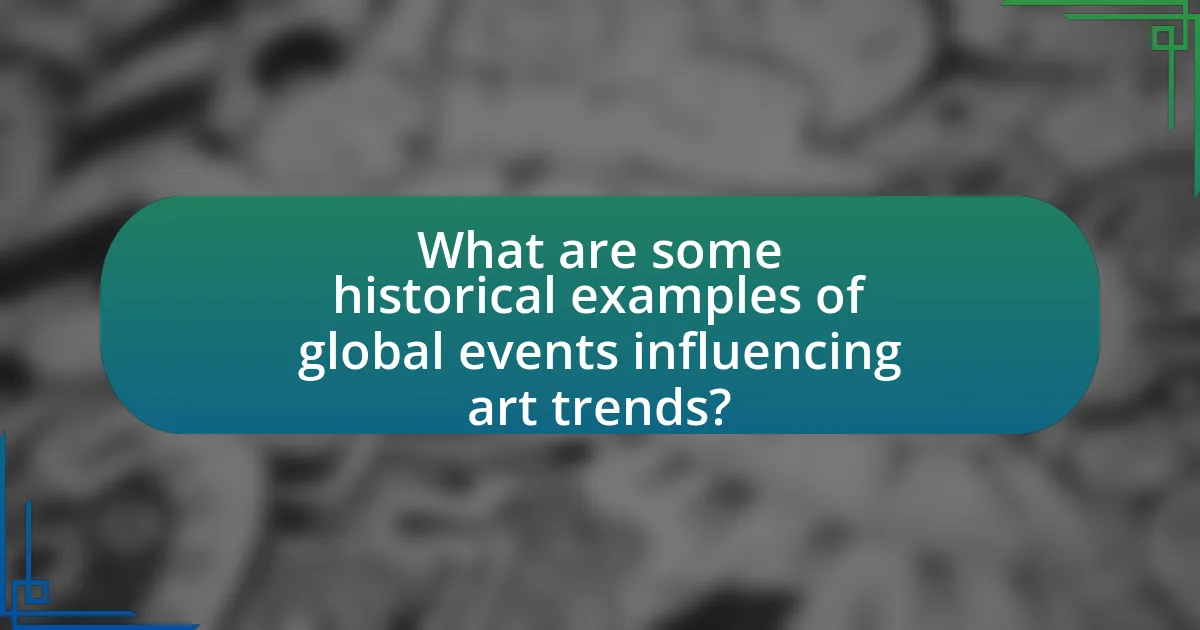
What are some historical examples of global events influencing art trends?
Global events have significantly influenced art trends throughout history, with notable examples including the Renaissance, the Industrial Revolution, and World War II. The Renaissance, which began in the 14th century, was driven by the rediscovery of classical philosophy and art, leading to a flourishing of artistic expression characterized by realism and humanism, as seen in the works of Leonardo da Vinci and Michelangelo. The Industrial Revolution in the 18th and 19th centuries introduced new technologies and urbanization, inspiring movements like Impressionism, where artists such as Claude Monet captured the changing landscapes and social dynamics of the time. World War II had a profound impact on art, leading to the emergence of Abstract Expressionism in the United States, as artists like Jackson Pollock responded to the chaos and trauma of war, emphasizing individual expression and spontaneity. These events illustrate how societal changes can shape artistic movements and styles.
How did World War II affect artistic movements?
World War II significantly transformed artistic movements by prompting a shift towards abstraction and existential themes. The war’s devastation and the subsequent disillusionment with traditional values led artists to explore new forms of expression, such as Abstract Expressionism, which emerged in the United States during the late 1940s. This movement emphasized spontaneous, automatic, or subconscious creation, reflecting the chaotic nature of the post-war world. Additionally, the horrors of the Holocaust and the atomic bomb influenced artists like Pablo Picasso and Francis Bacon, who depicted themes of suffering and existential dread in their works. The war also catalyzed the rise of movements such as Surrealism and Dadaism, which challenged conventional aesthetics and societal norms, as artists sought to confront the absurdity of human existence in the face of widespread destruction.
What specific art movements emerged as a response to the war?
Dadaism and Surrealism emerged as specific art movements in response to the war. Dadaism, which originated during World War I, rejected traditional artistic values and embraced chaos and absurdity as a reaction to the horrors of war. Surrealism followed, influenced by the disillusionment of the war, aiming to explore the unconscious mind and challenge rational thought. Both movements reflected the societal trauma and questioning of reality that arose from the conflict, showcasing how global events directly shaped artistic expression.
How did the war change the themes and subjects of art?
The war significantly altered the themes and subjects of art by shifting focus from traditional representations to more complex, often darker explorations of human experience. Artists began to depict the harsh realities of conflict, trauma, and the human condition, moving away from idealized forms and subjects. For instance, the aftermath of World War I led to the emergence of movements like Dadaism and Surrealism, which challenged conventional aesthetics and expressed disillusionment. Similarly, World War II influenced artists such as Pablo Picasso, whose work “Guernica” starkly illustrated the horrors of war and its impact on society. These changes reflect a broader trend where global events catalyzed artists to engage with contemporary issues, resulting in a more profound commentary on the human experience.
What role did the Civil Rights Movement play in shaping art?
The Civil Rights Movement significantly influenced art by inspiring artists to address social justice, racial equality, and cultural identity. This movement prompted the emergence of new artistic expressions, particularly in African American art, as artists sought to reflect the struggles and aspirations of their communities. For instance, the works of artists like Jacob Lawrence and Faith Ringgold incorporated themes of civil rights, using visual narratives to communicate the experiences of African Americans during this transformative period. Additionally, the movement fostered a sense of solidarity among artists, leading to collaborative projects and exhibitions that highlighted the importance of activism in art. The impact of the Civil Rights Movement on art is evident in the increased visibility of marginalized voices and the incorporation of political themes in various art forms, including painting, music, and literature.
Which artists were most influenced by the movement?
The artists most influenced by the movement include Pablo Picasso, Wassily Kandinsky, and Jackson Pollock. Picasso’s work during the Cubist movement was significantly shaped by the socio-political climate of his time, particularly the impact of World War I. Kandinsky, a pioneer of abstract art, drew inspiration from the tumultuous events of the early 20th century, reflecting the chaos and emotional intensity of the period in his compositions. Pollock’s development of the drip painting technique was also a response to the existential crises following World War II, embodying the spirit of American Abstract Expressionism. These artists exemplify how global events directly shaped their artistic expressions and styles.
How did the movement change the representation of marginalized communities in art?
The movement significantly transformed the representation of marginalized communities in art by amplifying their voices and experiences through diverse artistic expressions. This shift was marked by the emergence of artists from these communities who challenged traditional narratives and showcased their cultural identities, leading to greater visibility and recognition. For instance, the Black Arts Movement of the 1960s and 1970s emphasized African American culture and aesthetics, resulting in a surge of artworks that celebrated Black identity and addressed social issues. This movement not only influenced mainstream art but also inspired subsequent generations of artists to explore themes of race, gender, and social justice, thereby reshaping the art landscape to be more inclusive and representative of marginalized perspectives.
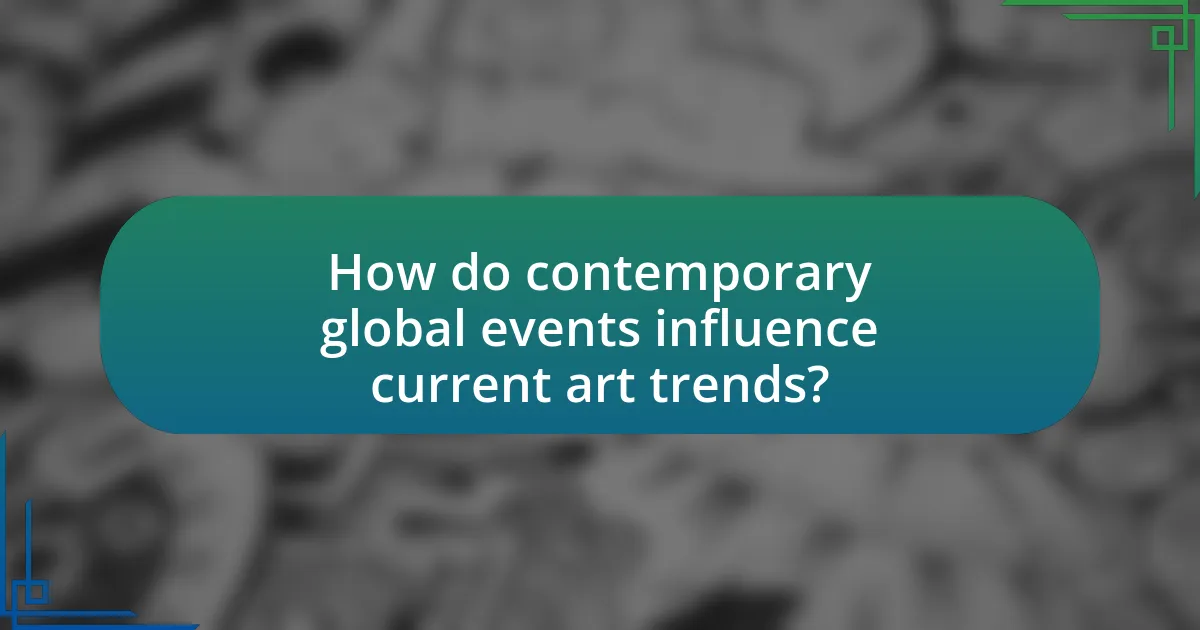
How do contemporary global events influence current art trends?
Contemporary global events significantly influence current art trends by shaping the themes, mediums, and messages artists choose to explore. For instance, the COVID-19 pandemic prompted a surge in digital art and virtual exhibitions, as artists adapted to social distancing measures and sought new ways to engage audiences. Additionally, movements such as Black Lives Matter have inspired artists to address social justice issues, leading to a rise in politically charged artwork that reflects societal concerns. The impact of climate change has also led to an increase in eco-art, where artists use sustainable materials and themes to raise awareness about environmental issues. These examples illustrate how artists respond to and reflect the complexities of the world around them, making contemporary art a direct commentary on current global events.
What impact has the COVID-19 pandemic had on the art world?
The COVID-19 pandemic has significantly disrupted the art world by forcing galleries and museums to close, leading to a dramatic decline in physical exhibitions and sales. According to a report by Art Basel and UBS, the global art market contracted by 22% in 2020, with online sales increasing to 25% of the total market, highlighting a shift towards digital platforms. Additionally, artists faced challenges in creating and showcasing their work, resulting in a rise in virtual exhibitions and online engagement as alternatives to traditional venues. This transition has reshaped how art is consumed and sold, indicating a lasting impact on the industry’s structure and accessibility.
How have artists adapted their practices during the pandemic?
Artists have adapted their practices during the pandemic by shifting to digital platforms for creation and exhibition. Many artists transitioned to online galleries and virtual performances, allowing them to reach wider audiences despite physical restrictions. For instance, a survey by the National Endowment for the Arts in 2020 indicated that 63% of artists reported using social media to showcase their work, while 45% engaged in online sales. This adaptation not only maintained their visibility but also fostered new forms of collaboration and community engagement through digital means.
What new themes have emerged in art as a result of the pandemic?
New themes that have emerged in art as a result of the pandemic include isolation, resilience, and the re-evaluation of human connection. Artists have increasingly explored the emotional and psychological impacts of lockdowns, leading to works that reflect solitude and introspection. For instance, many visual artists have created pieces that depict empty urban spaces, symbolizing the absence of social interaction. Additionally, themes of community and collective healing have gained prominence, as seen in collaborative projects that aim to foster connection despite physical distance. The pandemic has also prompted a focus on health and the environment, with artists addressing issues such as public health crises and climate change in their work. These themes are evident in exhibitions and online platforms that showcase art responding to the unique challenges posed by the pandemic.
How do social media and technology play a role in the influence of global events on art?
Social media and technology significantly influence the impact of global events on art by facilitating rapid dissemination and engagement with artistic expressions related to those events. Platforms like Instagram and Twitter allow artists to share their work instantly, often in response to current events, thereby shaping public discourse and awareness. For instance, during the Black Lives Matter movement, artists used social media to amplify their messages, leading to increased visibility and support for social justice themes in art. Additionally, technology enables virtual exhibitions and online galleries, making art accessible to a global audience, which further enhances the connection between global events and artistic responses. This interconnectedness illustrates how social media and technology serve as catalysts for artistic innovation and cultural dialogue in the context of global happenings.
What platforms are most effective for artists to share their responses to global events?
Social media platforms such as Instagram, Twitter, and TikTok are most effective for artists to share their responses to global events. These platforms allow for immediate dissemination of visual and textual content, enabling artists to engage with a global audience in real-time. For instance, Instagram’s visual-centric approach facilitates the sharing of artwork that responds to current events, while Twitter’s character limit encourages concise commentary and discussion. TikTok’s short video format allows artists to creatively express their perspectives through engaging content, reaching younger demographics. According to a 2021 report by the Pew Research Center, 69% of adults in the U.S. use social media, highlighting its significance as a tool for artists to connect and communicate their responses to societal issues.
How has technology changed the way art is created and consumed during global events?
Technology has significantly transformed the creation and consumption of art during global events by enabling digital platforms and tools that facilitate remote collaboration and access. Artists now utilize software for digital painting, 3D modeling, and virtual reality, allowing them to create art from anywhere, even during lockdowns or crises. For instance, during the COVID-19 pandemic, platforms like Zoom and social media became essential for artists to share their work and engage with audiences, leading to a surge in online exhibitions and virtual galleries. This shift has democratized access to art, allowing a broader audience to experience and interact with art forms that were previously limited to physical spaces. According to a report by Artsy, online art sales reached $12.4 billion in 2020, highlighting the growing importance of digital consumption in the art world during global disruptions.
What are some best practices for artists responding to global events?
Artists responding to global events should prioritize authenticity, empathy, and engagement with their audience. Authenticity ensures that the artist’s voice resonates genuinely with the issues at hand, fostering a deeper connection with viewers. Empathy allows artists to understand and reflect the emotions and experiences of those affected by the events, creating work that is both relevant and impactful. Engaging with the audience through discussions, social media, or community projects can amplify the message and encourage collective reflection. For instance, during the COVID-19 pandemic, many artists used social media platforms to share their experiences and connect with others, demonstrating the power of art as a tool for solidarity and healing.
How can artists effectively communicate their messages through their work?
Artists can effectively communicate their messages through their work by utilizing symbolism, visual language, and context. Symbolism allows artists to convey complex ideas and emotions through recognizable images, while visual language, including color, form, and composition, can evoke specific feelings and reactions from the audience. Context plays a crucial role, as artists often draw inspiration from global events, societal issues, or personal experiences, making their work relevant and relatable. For instance, the rise of social media has enabled artists to reach wider audiences, facilitating discussions around contemporary issues, as seen in the works of artists like Ai Weiwei, who addresses human rights and freedom of expression through his art.
What resources are available for artists to engage with global issues through art?
Artists can engage with global issues through various resources, including grants, collaborative platforms, and educational programs. Organizations such as the Creative Capital Foundation provide funding specifically for projects that address social issues through art. Additionally, platforms like Art for Amnesty and the Global Arts Corps facilitate collaborations between artists and activists, enabling them to create impactful works that raise awareness about global challenges. Educational institutions also offer workshops and courses focused on socially engaged art, equipping artists with the skills to address pressing global issues effectively.
